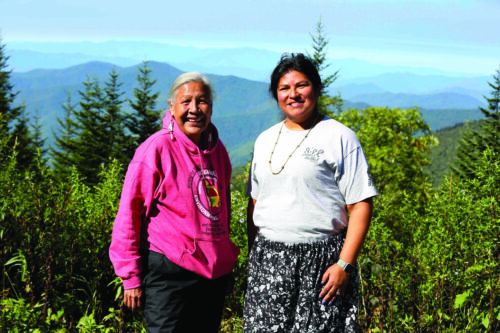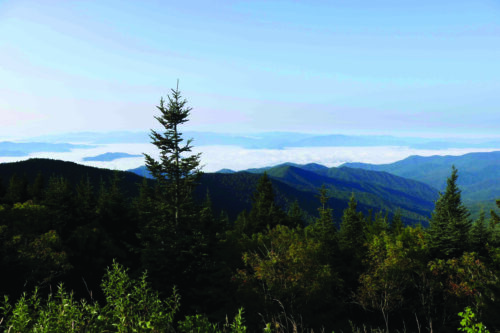By SCOTT MCKIE B.P.
One Feather Asst. Editor
KUWOHI – The name of the third-highest summit east of the Mississippi River has been restored to its original name. The U.S. Board on Geographic Names (BGN) approved an application on Wednesday, Sept. 18, 2024 that restores the name of Clingman’s Dome, in the Great Smoky Mountains National Park (GSMNP), to its original Cherokee name, Kuwohi (mulberry place).
Lavita Hill and Mary “Missy” Crowe, both members of the Eastern Band of Cherokee Indians (EBCI), started this effort in 2022 and received widespread support for the initiative.

Mary “Missy” Crowe and Lavita Hill, both members of the Eastern Band of Cherokee Indians (EBCI), who started the effort in 2022 to restore the name of Kuwohi, are shown at the mountain on the morning of Tuesday, Sept. 10, 2024. (SCOTT MCKIE B.P./One Feather photos)
On Wednesday, Crowe told the One Feather, “Thank you Creator God for the many blessings we received during this journey to restore Kuwohi. Thank God for my sister, Lavita Hill, and her husband, Chris Siewers, who went above and beyond in this effort to restore Kuwohi! There are so many to thank who have supported us along this journey, but especially want to say thank you to the Thomas Lanier Clingman family and Tom Clingman for supporting Lavita and I in our efforts.”
Hill told the paper, “My mind is all over the place right now. I am still in a little bit of shock. But I feel like this is an incredible victory for our people. What started as a fun idea transpired into reclaiming our native language on a significant mountain within the park. Before my first visit to Kuwohi to meet with a reporter I was nervous, but my sister said our ancestors are with you. And that gave me the motivation and determination to do the work.
Many thanks to our Creator God, for this blessing to our people! EBCI, this is for each of you. I now know more Cherokee history than before this journey began and I want to thank our ancestors for their ingenuity and commitment to preserving our culture and keeping us here in the mountains.
Thank you, Missy Crowe, for all that you do and the way you honor our people and the Earth. You are a light! Thank you to the Clingman family for their support. Thanks to everyone for your words of inspiration when they were needed. And mostly, thanks for my husband, Chris Siewers, for believing in me enough to encourage, sometimes push, me to do the work, and more importantly, for working alongside me throughout each step of this journey. Lastly, this is for Aura, Aia, and Raven – thank you to my kids for believing in me and giving me a reason to go do the challenging things. Sgi to the U.S. BGN! GvGeYu EBCI.”
Following the announcement on Wednesday, GSMNP Superintendent Cassius Cash said in a statement, “The Great Smoky National Park team was proud to support this effort to officially restore the mountain and to recognize its importance to the Cherokee People. The Cherokee People have had strong connections to Kuwohi and the surrounding area, long before the land became a national park. The National Park Service looks forward to continuing to work with the Cherokee People to share their story and preserve this landscape together.”
GSMNP officials noted that more than 650,000 people visit Kuwohi annually. Information from the park states, “Clingmans Dome has always been known as Kuwohi to the Cherokee People. The mountain became known as Clingmans Dome following an 1859 survey by geographer Arnold Guyot, named for Thomas Lanier Clingman who was a lawyer, U.S. Representative and Senator from North Carolina, and Confederate Brigadier General.”
The Dinilawigi (Tribal Council) of the EBCI passed Res. No. 72 (2024) unanimously during its regular session on Thursday, Jan. 4, 2024 that approved the submittal of an application on behalf of the Tribe to restore the name.

Kuwohi (mulberry place)
The application to BGN was filed by Hill and Crowe on behalf of Ugvwiyuhi (Principal Chief) Michell Hicks and Dinilawigi on Tuesday, Feb. 6, 2024.
Res. No. 72 speaks to the support for the name restoration regionally stating, “…community support for the restoration of the Kuwohi name has been overwhelming, including formal support from multiple local governments, including the counties of: Buncombe, Haywood, Jackson, Macon, Swain, Graham, Clay, and Cherokee, and the towns of Asheville, Andrews, Murphy, Hayesville, Fontana Dam, Lake Santeetlah, Robbinsville, Canton, Clyde, Maggie Valley, Waynesville, Dillsboro, Sylva, Webster, the Village of Forrest Hills, Franklin, Highlands, and Bryson City in western North Carolina, and the counties of Knox and Cambel in eastern Tennessee.”
In 2023, Hill and Crowe were recognized for their efforts by the Tennessee General Assembly with the passage of Bill H.J. 452. That legislation, submitted by State Rep. Justin Jones (D-District 52), stated, “Ms. Crowe and Ms. Hill are testaments to the power of dedication and determination, and their laudable mission deserves to be acknowledged; now, therefore, be it resolved by the House of Representatives of the One Hundred Thirteenth General Assembly of the State of Tennessee, the Senate concurring, that we honor and commend Mary Crowe and Lavita Hill on their efforts to restore the traditional Cherokee name of ‘Kuwohi’ to Clingman’s Dome in the Great Smoky Mountains National Park and wish them all the best in their future endeavors.”
That legislation passed 92-0 in the Tennessee House of Representatives on March 20, 2023, and it passed 31-0 in the Tennessee Senate on March 30, 2023. Gov. Lee signed it on April 11, 2023.
Dinilawigi passed legislation on July 14, 2022 which officially lent support from the EBCI for the name restoration effort. That legislation, submitted by Crowe and Hill, describes the area, “Kuwohi or ‘mulberry place’, is the highest point in our area and has significance to us as Cherokee as it was visited by medicine people who prayed and sought guidance from the Creator regarding important matters facing our people, and then returned to our towns to give guidance and advice.”





